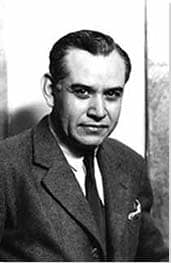Summary of Rufino Tamayo
The painter and printmaker Rufino Tamayo - or the "International Mexican" as he liked to be known - was a contemporary of the so-called "big three" Mexican Muralists, Diego Rivera, José Clemente Orozco, and David Alfaro Siqueiros. Unlike his esteemed countrymen, however, Tamayo veered away from pro-revolution political statements preferring to promote ideas of personal freedom and liberty; art that could, in his words, relate, not just to Mexicans, but to "everybody, everywhere". His unique style blended elements of the European avant-garde, including Impressionism, Cubism and Fauvism, with Mexico's proud Pre-Columbian heritage. Tamayo can take credit for helping place Mexican modernism firmly on the international map, while his domestic influence has been especially profound, with many next generation Mexican artists finding confidence in expressing their individual voices through Tamayo's example.
Accomplishments
- At a time when his contemporaries were using art to advance revolutionary political dogma, Tamayo was engaged with more neutral themes, many touching on feelings of tranquility and pleasure. Tamayo offered a credible alternative to the "big three" muralists (Rivera, Orozco, and Siqueiros) by refuting the rule that modern Mexican art must serve an overtly socialist agenda. It was a path that saw him rejected by Mexico's arts establishment. Unbowed, Tamayo went on to produce paintings that did much to broaden the appeal of Mexican art on the international art scene. It was this crossover of cultures, indeed, that earned him the moniker the "International Mexican".
- Many of Tamayo paintings are filed with fruit: avocados, pineapples, apples, peaches and so on. For the artist, fruit was a potent reminder of his childhood and working for a successful family fruit seller. But it is perhaps the watermelon, referred to in his work as a Mexicanidad (the quality of "being Mexican"), that recurs throughout his oeuvre. Fruit - a symbol of fertility in art history - also resonates on a more emotive level in Tamayo's art given that he and his wife, Olga, suffered several miscarriages (leaving the devoted couple childless).
- Tamayo's art foregrounds his compositional method rather than place emphasis on subject matter. His preference was for a limited color palette, believing that fewer colors imbued the artwork with greater force and meaning. His fondness for pure colors, especially reds and purples, rather than limit the painting, maximize, in Tamayo's point of view, a composition's possibilities. In other words, he believed that it was more stimulating to test the possibilities of a single color than to employ a limitless field of pigments.
- Tamayo produced many graphic works and developed, a unique print technique that he (and collaborator Luis Remba) called "Mixografia". The "Mixografia" sees a design, such as Luna y Sol (Moon and Sun) (1990), etched onto a plate before then being covered in ink. But rather than just press the plate against a sheet of paper, the "Mixografia" process takes the added step of applying cotton fiber pulp over the ink. Once the plate and pulp are put under pressure, the print takes on a unique tactile quality that also results in a rich saturation of colors.
The Life of Rufino Tamayo
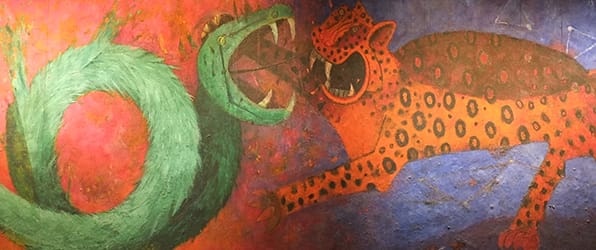
Tamayo was at heart a patriot, "My sentiment is Mexican, my color is Mexican, my forms are Mexican [...] Being Mexican, nourishing myself from the tradition of my land", but at the same, he spoke of "receiving from the world and giving to the world as much as I can: That is my creed as an international Mexican."
Important Art by Rufino Tamayo
Niños (Children)
In 1921, Tamayo began working for the Department of Ethnographic Drawing at Mexico's National Museum of Anthropology. He was placed in charge of recreating pre-Columbian (or Pre-Hispanic) art pieces for public exhibitions. This task would fire his own passion for the ancient art of primitive Mexican civilizations. He worked at the museum until 1926 when he held his first solo exhibition in the city. The exhibition, in which Niños featured, was a great early success for a new artist whose work was far removed from the political upheavals that affected the country following the 1911 revolution (and in fact lasted for some thirty years).
At a time when the "big three" muralists, Diego Rivera, José Clemente Orozco, and David Alfaro Siqueiros, were focusing their art on Mexico's current political situation, Tamayo's painting conveyed a sense of neutral tranquility. Given the context in which it was produced, it might even have been read as a sign of quiet national optimism. Pre-Columbian art - a term given to Southern and North American art before the arrival of Columbus and the dawning of the "New World" - was a primitive art that focused on how humans interacted with their physical and sacred worlds, and on maintaining a lineage with the histories and traditions of ancestors. In this vein, Niños presents a simple ("childlike") and gaily colored, composition in which a boy in shorts and a tan hat holds hands with a girl in a white dress and black hair (or black head covering). She is carrying a small bouquet of flowers which indicates perhaps the pair are young carefree sweethearts walking in their unspoiled land.
Later in his career children featured in Tamayo's art in a more distressed manner that reflected the horrors of World War II. His Niños Jugando con Fuego (Children Playing with Fire) (1947), for instance, also features two children but he represented them with frighteningly large black eyes, silhouetted against large, lashing orange and yellow flames. Tamayo stated that the "war children" were being burned and that the painting was a metaphor for the way in which the next generation of Mexican children (and, indeed, children across the world) had been "scorched" by their political choices and actions of their elders. He stated, "the danger is that man may be absorbed and destroyed by what he had created" and, by extension, the blissful innocence of images such as Niños were at risk of becoming lost to the past.
Oil on canvas - Private collection
Mujeres de Tehuantepec (Women of Tehuantepec)
Although Tamayo's work never fully engaged with Cubism, it could certainly demonstrate its influence, as in Mujeres de Tehuantepec, which employs strong geometric and linear qualities in its depiction of a busy Mexican market scene. Front and center stand two women, one in a white dress, carrying a yellow and red basket of apples on her head, and looking directly at the viewer, the other, wearing a light dress and a red bow in her hair, stares at the first woman. Curator and historian Michael Brenson observes that many of Tamayo's figures of the 1930s and 1940s are "statuesque, with simple people, like fruit sellers, suggesting the appearance and authority of pre-Columbian statues". Indeed, the grey skin of the women adds to the idea of the statuesque.
The two central women, and their positioning relative to one another, is almost mirrored by two others at the right-side in the background who are faced away from the viewer. However, the second pair of women both wear white, and the fruit basket atop the head of the woman on our right is empty (without apples, in other words) thus negating the idea of a straightforward mirror reversal. A dark-skinned boy in the bottom right corner holds out a bouquet of flowers, while on the left-hand side of the picture frame, a pink wall features a checkerboard pattern, emphasizing perhaps Tamayo's interest in geometric forms.
The scene is teeming with images of fruit, including large barrels of avocados, pineapples, and other fruit just behind the women in the foreground, and apples, peaches, and other smaller fruit that lay strewn on the ground. In 1948 Mexican poet Xavier Villaurrutia said of Tamayo's representations of fruit that it was "charged with a magical symbolic power". Indeed, in this, and numerous other works, Tamayo includes fruit both as a reminder of his childhood and of the country in which he grew up. As an orphaned boy he moved to Mexico City to live with his aunt Amalia who he helped run the family's fruit business. Additionally, the fruit motif - fruit being a recognized symbol of fertility in art history - can be viewed as being of more personal significance for the childless Tamayo and his wife Olga (who sadly miscarried on a number of occasions).
Oil on canvas - Albright-Knox Art Gallery, Buffalo, New York
La Mujer con Máscara Roja (The Woman with the Red Mask)
In this painting, a dark-skinned woman is shown seated on a high-back chair. She appears nude, except for a swathe of red fabric that covers her hair like a veil, cascades down her back, and covers her lap. She also wears a red mask and she holds a red mandolin. Several circular elements are outlined, including the curved form of the mandolin, and the woman's ears and nipples.
This work blends elements of Mexican history and Modern Western painting. The squared, muscular shoulders recall the forms of many pre-Columbian sculptures, just as the earthy, deep browns and reds were inspired by pre-Columbian ceramics. At the same time, the style in which the work was painted is somewhat Cubist, and the composition clearly mimics that of Picasso's Girl with a Mandolin (1910). The mask, meanwhile, can be understood as carrying dual significance as it both recalls the masks worn by indigenous Mexicans, and references the interest in primitive (especially African) masks that were influencing with the European avant gardists, including Picasso, Modigliani, and other Cubists and Fauvists.
Oil on canvas - Private collection
Perro Aullando a la Luna (Dog Howling at the Moon)
The last work in Tamayo's Animals series, and painted while he was living in New York, Perro Aullando a la Luna depicts a red dog that fills most of the frame. Its head is raised high, veins are visible under its throat and on its chest, and it howls under the eclipsed moon to the left-hand side of the frame. The background is a monochromatic blue. A section of grey-green wall stands to the right of the image, and on the ground below there is a red bowl filled with blue bones, as well as two yellow bones on the floor to the left. Behind the dog to the left is a tall silhouetted triangular form, perhaps a coniferous tree. The dog's positioning and limited color palette indicates that Tamayo drew inspiration from pre-Columbian artifacts that represented Xoloitzcuintli (Mexican Hairless) dogs which were commonly found at tombs in the states of Colima and Veracruz; it is believed by the Aztecs that the Xoloitzcuintli served as guides when their owners crossed into the afterlife.
Art historian James Oles suggests that the section of wall in the painting "reinforces our sense that the dog is outside, unprotected, and perhaps unheard, as were so many voices in that terrible year of the Second World War, when democracy and freedom seemed irrevocably eclipsed by fascist victories". This work, and the others from Tamayo's Animals series, were influenced by Picasso's Guernica (1937), and particularly the Spaniard's images of a raging bull and screaming horse. As curator E. Carmen Ramos notes, "Guernica in particular struck Tamayo to the core. It really signaled a different approach to engage with the crises of the day". But historian Robert Goldwater notes that Tamayo's animals "express a spirit of revolt rather than the passive anguish Picasso depicted". This work in particular influenced younger generations of Mexican artists; most notably, perhaps, Alfonso de Pablos Vélez who, to commemorate Tamayo's death, recreated the dog in a sculpture titled, Un Viaje de Regreso (A Journey Back) (1991).
Oil on canvas - Private collection
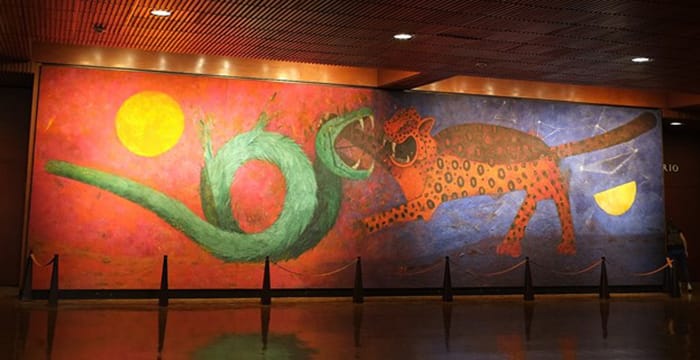
Dualidad (Duality)
Dualidad was created for the opening of Mexico City's Museum of Anthropology and History, and represents the dualities (day vs. night, good vs. evil, life vs. death, creation vs. destruction, masculine vs. feminine, and knowledge vs. ignorance) that give order and new purpose to the ancient Southern Mexican Nahuatl culture. On the left, the deity Quetzalcóatl (a coiled feathered serpent) is depicted against a bright red background, with a yellow circular sun in the top left corner. Quetzalcóatl is in active combat with his brother, the deity Tezcatlipoca (a jaguar) who occupies the right half of the mural and is pitched against a blue background, with celestial constellations and a yellow half-moon behind. Both creatures have mouths open, and fangs bared. As anthropologist Julio Amador Bech explains, the opening of the Museum of Anthropology and History occurred "during a period of rediscovery and recovery of Mexico's ancient roots in the 1960s, and the content of Tamayo's mural aligned perfectly with that aim".
Although Tamayo's earlier murals complemented the work of the great Mexican muralists Rivera, Orozco, and Siqueiros, their work employed subdued tones that reflected the serious mood of the socio-political concerns they were addressing. By the 1960s, and having lived in New York and for an extended period in Europe, Tamayo had learned to become more introspective. In this handsome mural, therefore, we see a focus on simpler compositions and more universal themes that were best expressed by him through what he admired most in Pre-Hispanic symbolism.
Sand on linen and vinelite cloth - Museum of Anthropology, Mexico City, Mexico
Retrato de Olga (Portrait of Olga)
Tamayo painted a total of twenty portraits of Olga, his devoted wife and supporter for fifty-seven years of married life. This portrait was painted to commemorate their thirtieth anniversary. It presents a seated Olga wrapped in a brilliant yellow shawl, against a reddish-orange background. Tamayo's use of such bright colors served to emphasize the couple's Mexican origins. On a wooden table behind her sits a slice of watermelon, a recurrent symbol of Mexicanidad - simply "the quality of being Mexican" - in Tamayo's oeuvre. At the same time, the work shows a subtle Cubist influence in its style, thus indicating that the couple had become what he called "international Mexicans": both rooted to their homeland, and active citizens in the Western world.
Juan Carlos Pereda of the Museo Tamayo Arte Contemporáneo, explains that "Olga acted as a kind of icon for Tamayo" and was a recurrent subject in his paintings (Rufino and Olga (1934), Portrait of Olga (1935), and Olga, Dynamic Portrait (1958), for instance). Pereda considers this portrait to be in fact "the most beautiful and important for the history of art" and that Tamayo "portrayed [Olga] as a sort of Madonna, a powerful woman full of refinement with enormous calm and great peace". He observes that Olga's face possesses an "unconventional beauty" the like of which could be found in pre-Hispanic sculpture. He notes too that she "has symbols on her cheeks that Tamayo possibly associated with pre-Hispanic deities, such as Coyolxauhqui, who wears bells on her cheeks". Yet, as Pereda also notes, Tamayo paints Olga with an expression of melancholy: "These portraits of Olga are riddles, mysteries, encrypted stories so that each one can fill them with their own experience, information and, above all, sensitivity".
Oil on canvas - Museum of Contemporary Art, San Diego
Luna y Sol (Moon and Sun)
This simple composition is divided diagonally, with a mottled dark-blue background on the left-hand side, and a mottled yellow background on the right. Against the blue background is positioned a crescent moon with human features, looking up at the round yellow sun atop the yellow background, which also has human features. The facial expressions of the two celestial objects are difficult to decipher; they may be either smiling or glaring in anger at one another. Luna y Sol (Moon and Sun) was the last work created by Tamayo, the year before his passing, and it is a clear depiction of the theme of duality, which defined many of his works from the 1950s onward.
It is also poignant to consider that a simple representation of day and night was the last work that the artist gave to the world. As Tamayo's friend, Octavio Paz, Mexican poet and Nobel laureate, once wrote "If I could express with a single word what it is that distinguishes Tamayo from other painters of our age, I would say, without a moment's hesitation: sun. For the sun is in all his pictures, whether we see it or not; night itself is for Tamayo simply the sun carbonized".
Tamayo produced many graphic works throughout his career, including woodcuts, lithographs, etchings, and "Mixografia" prints. The latter is a medium that he developed with Mexican printer and engineer Luis Remba, which used a technique that allowed him to produce prints with a certain amount of relief, resulting in a three-dimensional texture. The "Mixografia" process begins the same way as traditional printmaking, with a design being etched or imprinted onto a plate that is then covered in ink. However, instead of pressing the plate against a sheet of paper, "Mixografia" adds the step of applying cotton fiber pulp over the ink, and then the plate and pulp are put under extremely high pressure, which pushes the pulp into the plate and blends it with the ink. In addition to the unique textural qualities this method produces, it also results in intensely rich colors.
Mixograph on handmade paper - Los Angeles County Museum of Art, Los Angeles, California
Biography of Rufino Tamayo
Childhood
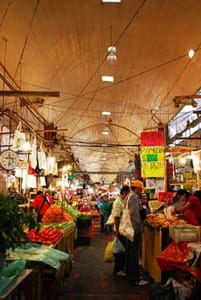
Rufino del Carmen Arellanes Tamayo was born in Oaxaca, Southern Mexico, to Zapotec (the name given to the indigenous people of the Oaxaca region) parents Manuel Arellanes, a shoemaker, and Florentina Tamayo, a seamstress. His father abandoned the family when Tamayo was still just a boy, and he later dropped his father's last name in favor of his mother's. Tragedy struck when his mother died of tuberculosis in 1907, and his grandmother passed soon after. The orphaned Tamayo moved to Mexico City in 1911 to live with his aunt Amalia. He helped the family with the day-to-day running of its fruit selling business. As Tamayo matured, he was also able to study accounting through his role in the family business.
Tamayo later recalled, "I arrived in the capital when I was eleven years old, with an inheritance that my land bequeathed to me [...] My family sold fruit on a large scale, in wineries in La Merced. Some of my enemies try to offend me by saying that we only had a small stall ... Perhaps many of the fruits that are part of my painting today are the ones I saw then. Curiously, when I was a child I never craved those fruits, their shapes and colors fascinated me, but I was almost never attracted to their flavor". Tamayo had become in fact a talented guitarist before he discovered his natural aptitude for drawing, of which he said: "My first inspiration was some postcards called art that reproduced works of well-known painters. It was possible to acquire these cards on the streets of Palma at a cost of ten cents. The first exercise I imposed on myself was precisely copying those cards".
Education and Early Training
Although he very seriously considered a career as a musician, Tamayo opted instead to pursue the path of painting and duly enrolled in the Escuela Nacional de Artes Plásticas at San Carlos in 1917. While at the school he experimented with popular Modern artistic styles, including Cubism, Impressionism, and Fauvism, but always with the idea of giving his work a distinctively Mexican bent.
After only a few months at the school, Tamayo and some of his peers, including Agustín Lazo, Gabriel Fernández Ledesma, and Julio Castellanos, had become disillusioned with the lack of personal freedom permitted by the school. The group even staged a number of protests aimed at effecting changes in the curriculum. As Tamayo recalled, "As soon as I arrived at the school I perceived its mediocrity. I wasn't the only one to feel that repulsion [...] Our rebellion was directed against a teaching system that held that art should be a slavish copy of nature". The protests, however, were ineffective, and Tamayo left the school to continue his career in art under his own steam.
Tamayo began working for the controversial writer, politician, and philosopher José Vasconcelos Calderón - also known as the "cultural caudillo" ("cultural leader") of the Mexican Revolution - at the Department of Ethnographic Drawings at the National Museum of Archaeology. He recalled: "Vasconcelos helped me by [trying] to put into practice a pretty good idea: it was about the Ethnology Department creating its own handicraft workshop where it could collect samples of popular arts that, already at that time and because of tourism, were beginning to become corrupted".
Pre-Columbian art is a term given to the architecture and arts and crafts produced in North, Central, and South America, and the Caribbean Islands. It specifically refers to works made before the sixteenth century and the arrival of Columbus who effectively opened to doors to "New World" Europeanism. Pre-Columbian - or Pre-Hispanic - art is then a primitive art focused primarily on how native peoples interacted with their physical and spiritual worlds. The works, as well as serving important sacred purposes, maintained a lineage with the histories of ancestors. Tamayo's duties at the National Museum included producing drawings of the collection of pre-Colombian artifacts and Tamayo's enthusiasm made such an impression on Vasconcelos that he soon made him head of the department, even though he was still just 21 years of age. Tamayo said later of his time at the National Museum: "[it] opened a world for me; I got in touch with pre-Hispanic art and popular arts. I immediately discovered that there was the source for my work: our tradition. So I tried to forget what I had learned at the School of Fine Arts, I even hardened my hand to start again. I began to deform things, always thinking of pre-Hispanic art [...] In pre-Hispanic art, there is absolute freedom when it comes to proportions. I also noticed the colors that our ancestors used".
In 1925, Tamayo rented his first (small) studio on Calle de la Soledad, near the Merced market, and turned his attention to his own painting practice. One year later, he organized his first solo exhibition of twenty oil and watercolor paintings in a space he rented in on Avenida Madero Pasaje América (which had previously been occupied by a gunsmith). As he explained, "at that time the only exhibition halls were within the walls of the academy, but I refused to exhibit my works there. The alternative was to rent a space in that central street". The exhibition proved a success and was generally well-received by critics.
Mature Period
In 1926, Tamayo travelled to New York City for the first time with the musician and composer Carlos Chávez. On a tight budget, the friends rented the attic of a house which they shared with other painters. Living alongside Marcel Duchamp, Stuart David, and Reginald Marsh, Tamayo said that his first trip to New York was "one of the most important aspects" of his artistic development, and where "I learned to let go of my hand, to overcome the vices that I had acquired in school, to discipline myself, to overcome loneliness and misery". Just one month after his arrival in New York, he exhibited 39 works at the Weyhe Gallery. It did much to increase his profile, not only in New York, but also back in Mexico.
In 1929, Tamayo returned to Mexico and took a position teaching painting, sculpture, and engraving at the National School of Fine Arts; urging his students: "If you like painting, paint every day, and if you can, [for] eight hours a day". Through his tutorial role, Tamayo inadvertently found himself at odds with the philosophical approaches of the "big three" Mexican Muralists, Diego Rivera, José Clemente Orozco, and David Alfaro Siqueiros, all of whom were engaged with Revolutionary themes. Tamayo believed (somewhat controversially) that the Revolution was harmful to the nation, and duly focused his art more on Pre-Hispanic influences. In fact, his refusal to paint a mural with overt Revolutionary content saw him expelled from the Union of Painters and Sculptors.
One of Tamayo's students was Maria Izquierdo. She and Frida Kahlo would become Mexico's most important twentieth century female artists. Tamayo and Izquierdo became lovers and shared a studio in Mexico City's historic center between 1929-33. The pair were also members of a group of writers and artists who called themselves the "Contemporaneos" (the "Contemporaries"). The group published a journal "Contemporaneos" between 1928-31, which took an oppositional view to the political muralists (in favor of a Pre-Hispanic Mexican art). In 1933, Tamayo was commissioned to paint his first mural, El Canto y la Música (The Song and the Music), for the National Conservatory of Music in Mexico City. While working on the mural, he met the concert pianist Olga Flores Rivas, who he married the following year. The couple remained married until Tamayo's passing fifty-seven years later with Olga assuming the role of her husband's most enthusiastic supporter and promoter.
In 1935, Tamayo did join the League of Revolutionary Writers and Artists (LEAR). It was an organization that sought to support Mexican artists who wanted to freely express their views, but particularly those who supported the Revolutionary War and other socialist political causes. Although Tamayo remained apolitical, and did not side with the views of Siqueiros and Orozco, they, and four other artists, represented Mexico at the first American Artists' Congress in New York (also in 1935).
Tamayo's niece and biographer María Elena Bermúdez Flores writes that while Rivera, Orozco, and Siquieros "endorsed the government's leadership over artistic expression tooth and nail and believed that art should be nationalistic", Tamayo believed that "to create art it is essential to work within a framework of absolute freedom: art must be universal and its nationalist traits must emerge spontaneously". His views came to be seen by many within Mexico's arts establishment as bordering on treason, and he was ostracized to the point that he felt he had no choice but to leave the country and, in 1936, he and Olga moved to New York City. (The couple stayed in New York for 13 years, returning on vacation to Mexico every summer. Much to the couple's sorrow and anguish, Olga suffered numerous miscarriages during this time, and they never became the parents they longed to be.)
The historian Edward J. Sullivan states that Tamayo, "saw what was going on in New York, where he really grew up as an artist and became disillusioned with what he perceived as the empty political rhetorical statements of Rivera and the other muralists, and began to paint and do murals in a style quite divorced from theirs. He embraced international Surrealism [...] and incorporated elements of early New York School painters". Tamayo also worked for President Roosevelt's famous employment and infrastructure scheme, Works Progress Administration (WPA), for a period.
The recent Stock Market crash made his financial situation even more precarious than on his first stay in the city. However, he held an exhibition with fellow Mexican painter Joaquín Clausell at the John Levy Galleries. He recalled: "[the exhibition] was definitive in my life. A few days later, someone whom I didn't know arrived at my house: Valentin Dudenzing. He was the owner of one of the most important galleries in New York, and offered to be my dealer. I accepted. In time we became great friends. I will never forget that it was Dudenzing who made me big".
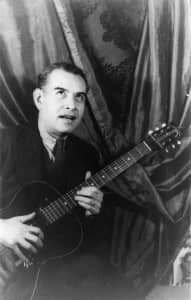
In 1938, Tamayo joined the Dalton School, where he successfully taught for nine years. One of his most successful pupils was American Abstract Expressionist painter Helen Frankenthaler. During his time in New York, he exhibited his work at numerous galleries, including the Valentine Gallery, the Knoedler Gallery, and the Marlborough Gallery. He also worked on set and costume design for a ballet, became friends with Henri Matisse, and, in 1946, began running his Tamayo Workshop from the Brooklyn Museum Art School.
In 1949, Tamayo and Olga set sail for Europe for the first time. They lived in Paris for the next decade. Although the couple felt a strong sense of homesickness for Mexico, Tamayo's time in Europe proved to be of great significance to his future career. In 1950, he, Rivera, Orozco, and Siqueiros represented México in the XXV Venice Biennale, although it was Tamayo who stood out from this distinguished pack. The Italian newspaper Il Corriere del Popolo de Milán, wrote: "Of the four Mexican painters who attended the Venice Biennale, Tamayo is the one most in line with current trends. Tamayo is the most current painter, the least political and the one who most remembers, in his easel works, the pre-Columbian sculptures of his homeland. A powerful colorist [...] Tamayo, without forcing the line and without torrential chromatic impetuosity, manages to express in exact synthesis the hallucinatory and imponderable spectacle of Mexico".
Late Period and Death
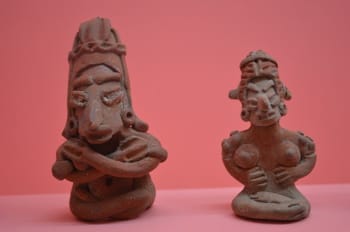
In 1974, having now returned to Mexico permanently, Tamayo donated 1300 Pre-Colombian artifacts to his hometown of Oaxaca, which were housed in the purpose-built Rufino Tamayo Prehispanic Art Museum (also opened in 1974). In 1980, the inauguration of the Galería Metropolitana de la Universidad Autónoma Metropolitana in Mexico City launched with an exhibition of Tamayo's art. Also in 1980, Tamayo was offered the Order of Quetzal from the government of Guatemala, but turned the accolade down, stating: "I did not accept it because my political ideas do not allow it; I am against regimes such as those that unfortunately prevail in almost all Latin American countries. I speak out against any dictatorship and I stand in solidarity with the peoples who are struggling to win their freedom since their struggle is the fairest of all".
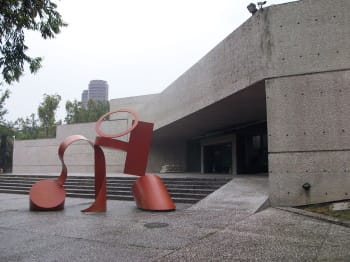
In 1981, the Rufino Tamayo Museum of Contemporary Art was opened on Mexico City's Paseo de la Reforma boulevard. It is home to around 300 works by Tamayo, and artifacts from his personal Mexican antiquities collection. It also houses works by Picasso, Bacon, Motherwell, Tápies, Miró, and Rothko. Tamayo enthused: "This collection will show you that under the sign of freedom it is possible for art to travel many paths and that these have to multiply as our world develops. The community will go from simple curiosity to becoming interested in a deep knowledge of what the schools exhibited in this museum represent". Indeed, just before the Museum opened its doors, Tamayo confronted his old adversaries, stating publicly: "You know the famous phrase of [the Mexican Social Realist] Siqueiros: 'Ours is the only path.' Can you believe that, to say that ours is the only path when the fundamental thing in art is freedom! In art, there are millions of paths - as many paths as there are artists".
On June 12, 1991, Tamayo was admitted to Mexico City's National Institute of Medical Sciences and Nutrition for respiratory and heart failure. He suffered a heart attack and died twelve days after admittance. His is buried in the grounds of his museum in Mexico City.
The Legacy of Rufino Tamayo
Rufino Tamayo played a significant role in the global art scene of the twentieth century. He both introduced the Western world to non-political Mexican art and brought the influence of Western modern art movements (especially Fauvism and Cubism) to Mexico. As curator Juan Carlos Pereda puts it, Tamayo "operated as the translator of this Mexican world, so complex, so beautiful, so unique, in other places, carried that heritage, that context, and turned it into something that is no longer merely Mexican, so that without ceasing to be Mexican it becomes another thing, that someone educated within the international avant-garde can appreciate".
As Octavio Paz, winner of the 1990 Nobel Prize for literature put it, "Tamayo radically changed Mexican painting, liberating it from academic superficiality and the revolutionary triviality of the muralists". This inspired (and brave) strategy paved the way for other Mexican artists of his own, and subsequent, generations - including his student Maria Izquierdo, and members of the Generación de la Ruptura like Lilia Carrillo, Manuel Felguérez, and Gustavo Arias Murueta - to feel liberated from what they had been told art should be, and to explore individual artistic styles and directions.
Influences and Connections

-
![Maria Izquierdo]() Maria Izquierdo
Maria Izquierdo -
![Henri Matisse]() Henri Matisse
Henri Matisse - Valentin Dudenzing
- Carlos Chávez
- Octavio Paz
-
![Helen Frankenthaler]() Helen Frankenthaler
Helen Frankenthaler -
![Manuel Felguérez]() Manuel Felguérez
Manuel Felguérez - Alfonso de Pablos Vélez
- Lilia Carrillo
- Gustavo Arias Murueta
-
![Maria Izquierdo]() Maria Izquierdo
Maria Izquierdo -
![Henri Matisse]() Henri Matisse
Henri Matisse - Carlos Chávez
- Octavio Paz
-
![Mexican Muralism]() Mexican Muralism
Mexican Muralism -
![Abstract Expressionism]() Abstract Expressionism
Abstract Expressionism - Mexican Modernism
- Generación de la Ruptura
 Ask The Art Story AI
Ask The Art Story AI